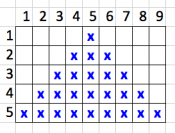Timon
Apprentice elf
I'd like to make a special matrix that is not rectangular and because of that I'd like to be able to skip pixels but keep the addresses so programming is easier. Here is an example.
take a 5 X 12 folded matrix which would normally take 60 pixels. I want to only us 34 because there is no grid area for the rest as the base is a triangle. So the live pixels would be 1, 21-31 and 39-60 and another one that would be 1-12, 15-31, 37-40 and 60 with both of those mapped into a DMX space starting at "N" through N+59.
Why you ask, to do something like this.
John
take a 5 X 12 folded matrix which would normally take 60 pixels. I want to only us 34 because there is no grid area for the rest as the base is a triangle. So the live pixels would be 1, 21-31 and 39-60 and another one that would be 1-12, 15-31, 37-40 and 60 with both of those mapped into a DMX space starting at "N" through N+59.
Why you ask, to do something like this.
John



